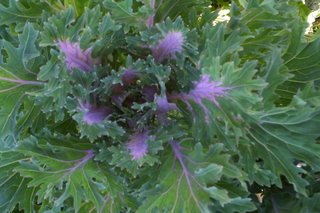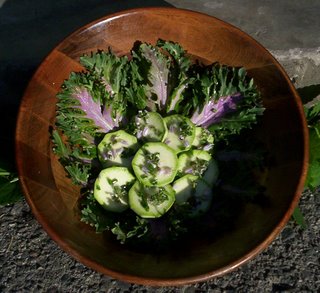Zabrina Mallow is the star of my garden right now. It sports a dozen 3 – 4 foot stems each bearing hundreds of 2 inch blossoms. The flowers vary from ivory to pale lilac, each one is marked with deep purple veins. Everyone who wanders past my yard stops to admire the flowers. If I am out in the yard they always want to know the name of those awesome flowers.

These fabulous flowers are also edible. They have a sweet tart flavor that goes well with fruit salads and looks smashing in punch and other cool drinks. But that’s not the only edible part. The young leaves are tender and mild and can be used in salads and stir fries. The older leaves are good for soups and mixed cooked greens. And the immature seed pods make a nice crunchy addition to salads and cooked dishes.
Each flower only lasts one day. The petals close in the evening, and by morning the ground is decorated with the faded purplish-blue blossoms. As the sun warms the air new flowers open, beckoning to the busy bumblebees and beneficial insects. There where yesterdays flowers used to be, ovaries are swelling with seed. I always show visitors where the seed is ripening and encourage them to come back in a month or so, when I will have seed to give away.
My Zabrina Mallow seed came to me as a gift, in the dead of winter. I sprouted the seeds indoors and once the little plants looked like they had a hope of staring down hungry slugs, out into the garden they went. They survived the winter deluge, as well as the few sprinklings of snow we received. And now, wow! I will have tons of seed to plant and share. And the show will be even bigger and brighter next year.
Zabrina Mallow is sometimes called Striped Hollyhock, but it isn’t a hollyhock at all. Hollyhocks tend to send up one very tall stem (6-10 feet) and their petals aren’t striped.
Biannual to short lived perennials, hollyhocks come in single, double, and frilled edible flowers up to 4 inches across. Hollyhock flowers can be dried to make a soothing tea that is sensational when mixed with mint, chamomile, or lemon balm. For the small garden there are dwarf hollyhocks that grow only 2 – 3 feet tops. All Hollyhocks will grow happily here in zone 8. They are available in white, black and almost every other color you can imagine.
If you like color in the garden, the Mallows are famous for colorful flowers. They are easy to grow and they are not too picky about soil or temperature. Just provide them with as sunny a spot as you can spare. Keep them watered until established and then, if necessary they can withstand occasional dry spells. Zabrina Mallow and Hollyhocks aren’t the whole story, Hibiscus, Lavatera, Malope, and Musk Mallow are all in the mallow family and have similar flowers.
Hibiscus will grow from 2 to 6 feet tall in a single season, and die back to the ground with the first frost. In frost free climates they are often perennial, and some will even resprout after a frost if they are given a sheltered place in the garden. They bloom in single colors with tropical looking flowers up to 4 inches across in reds, pinks, yellows, and white. Some of them have fancy cut-lace leaves, and there are even a few with foliage in interesting colors.
Lavatera and Rose Mallow are used interchangeably for hardy annual mallows with 2-3 inch flowers in single colors, often with deeper colored veins. Flowers are most often found in shades of pink or white. These plants can form a small bush generally from 2 – 3 feet tall, however there are both shorter and taller varieties available. Keep in mind that they will die back to the ground in fall. But if you need something to fill in temporarily between slower growing perennial plants, Lavatera might be just the ticket.
Malopes are the true bedding plants of the Mallows. They only reach two feet, at most. Their delicate blooms come in the standard mallow colors of pink, rose, and white. Unlike other mallows the throats of the flowers are often a deeper color than the edges of the petals, with the deep color extending out along the veins. These make nice annual additions to flower beds and the front of borders.
Mallow or Musk Mallows include annuals, biannual, and perennial species. They range from 12 inches tall all the way to 6 feet, depending on variety. Zabrina Mallow is a perennial member of this group. In our coldest mountain zones it is grown as an annual, but it sets copious seeds so one need only track down plants or seeds a single time. The Musk Mallows sport 2 inch blooms in white, purple, mauve, and pink The flowers are often deeply veined making very striking flowers.
There are two Mallow varieties grown specifically for the kitchen. Look for Curled Mallow and Red Chinese Mallow if you want something a little different for soups and salads. And then there is the true Marshmallow, an extract of which was originally an ingredient in the confection that goes by its name. Marshmallows do not have showy flowers but their light grey fuzzy leaves add an interesting contrast to the garden. Herbalist prize them for their soothing cooling tea.
Whether you are looking for flowers, a refreshing cup of ice tea, or something new and different for the kitchen one or more of the mallows are sure to fit the bill. If your local nursery doesn’t carry the mallows you would like to try, check out the following mail order sources: Richters for Curled Mallow, Hollyhocks and Marshmallow: (905) 640-6677
http://www.Richters.com / Select Seeds for a purple lace cut leaved hibiscus (called Red Shield), and Lavatera: (800) 253-5691
http://www.selectseeds.com/ and Thompson & Morgan for Zabrina Mallow and Malope: (800) 274-7333
http://www.thompson-morgan.comNext week we will be taking a look at ways to conserve water in the garden. Until then you can probably find me hiding from the heat down at the creek. (LOL) Oh yea, digging the dirt – that’s right. In the cool of the morning I am out in the garden Digging the Dirt.
Copyright 2006 Harvest McCampbell, from my column "Digging the Dirt," published in
The Hoopa Valley People Newspaper, July 5, 2006. Posted here with permission.
More Information:
Other Edible Flowers:
Basil
http://harvestsgardeningsecrets.blogspot.com/2006/07/bountiful-basil.htmlCilantro
http://harvestsgardeningsecrets.blogspot.com/2006/01/cilantro.htmlDaisies & Violets
http://harvestsgardeningsecrets.blogspot.com/2006/02/first-flowers-for-season-violets-and.htmlFennel
http://harvestsgardeningsecrets.blogspot.com/2006/01/florence-fennel-real-food.htmlGiant Red Japanese Mustard
http://harvestsgardeningsecrets.blogspot.com/2006/03/giant-red-japanese-mustard.htmlKale
http://harvestsgardeningsecrets.blogspot.com/2006/02/kindly-kale.htmlPumpkin
http://harvestsgardeningsecrets.blogspot.com/2006/05/jack-o-lanterns-pumpkin-pie.htmlSweet Alyssum
http://harvestsgardeningsecrets.blogspot.com/2006/06/sweet-alyssum.htmlDid I mention that Mallow attracts beneficial insects? Here is more on that topic:
Related articles on attracting beneficial insects:
Beneficial Insects More Beneficial Insects



